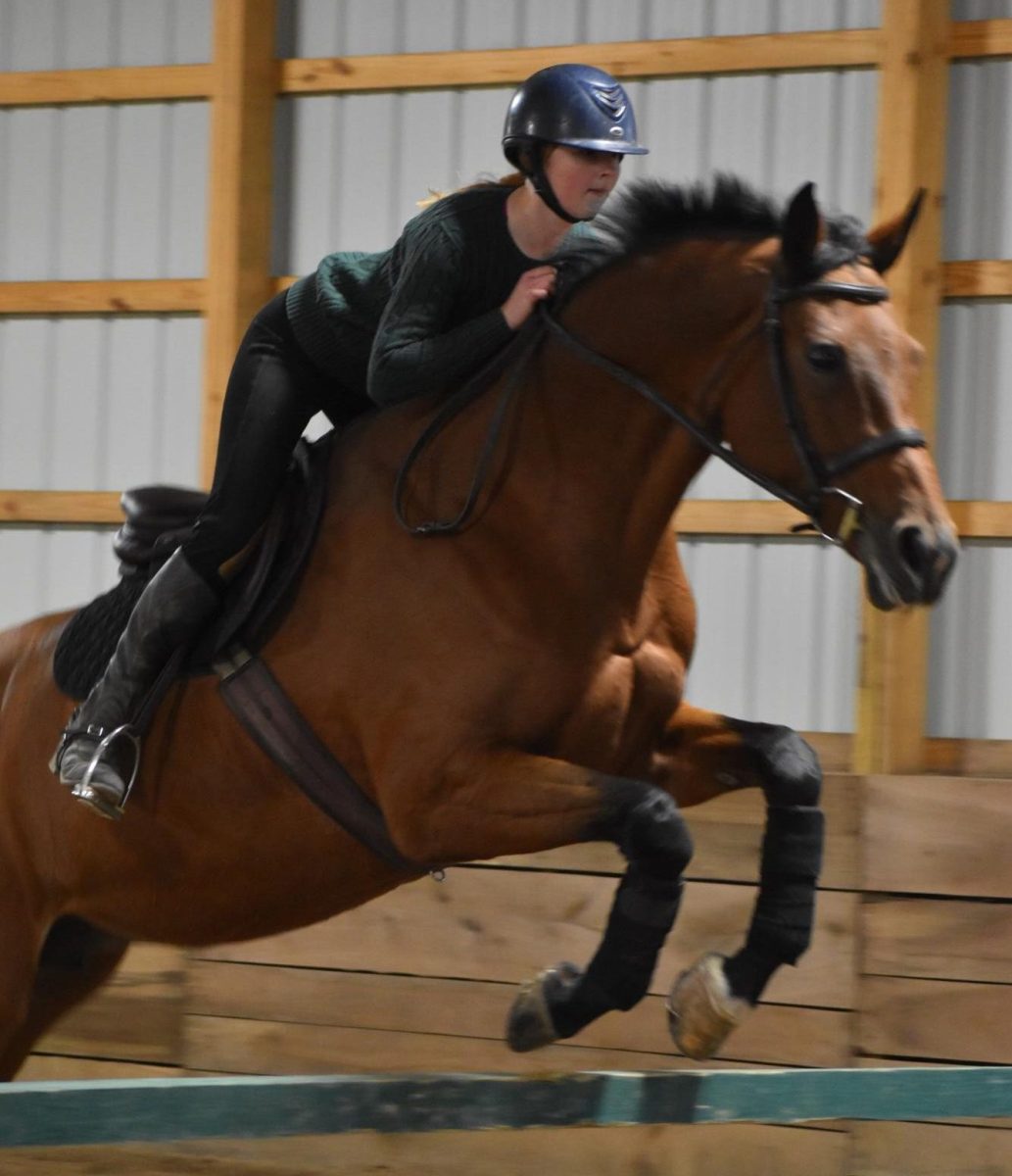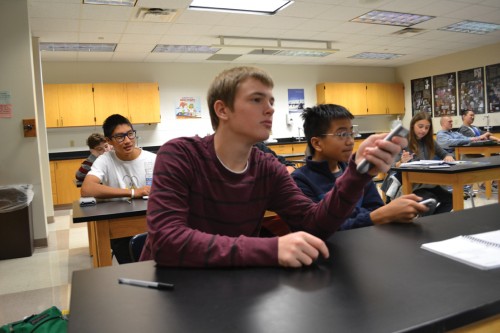
Imagine walking into class each day and instead of your teacher saying, “Get out your textbooks,” he or she says, “Get out your laptops.” This has become reality for the students in grades 5 through 12 in the Munster school district. All math and science classes have replaced their textbooks with computers. The district made an agreement to purchase 2,940 laptops from Dell, an estimated $2.5 million purchase, according to an article published in the New York Times.
Munster, along with many other school districts in the United States, is making the transition to a textbook-free curriculum. With new technological advances already adopted, and propositions for the near future, Carmel is not far behind these schools.
Science teacher Virginia Kundrat said she has implemented new technologies in her classroom. She said these new additions have helped the students become more “interactive.”
“I have a new quiz system in which my students will see a question on the board, and they each have a remote. They answer the questions using the remotes, and once my students have given the answer, it will show if the response is right or not,” Kundrat said.
According to Kundrat, there has been a positive reaction from the students to the new technology. Sophomore Delaney Brinson, a student of Kundrat, said, “I actually prefer the remote system to regular quizzes. I think this system has in fact helped my overall grade because it’s a lot easier to use. With the remotes, everyone has to become more involved and pay attention.”
Along with the “remote quizzes,” Kundrat said she assigns her classes online homework and quizzes. She said these changes have not had as positive of feedback.
Brinson said, “I’m on the fence about the online quizzes. They are usually easier because you are limited with the types of questions you can have, but some of the questions are timed so if you don’t know the answer right away you have a limited time to figure it out.”

Kundrat is not the only teacher who has added technology to her lessons. This year, the math department adopted the new ‘TI-Nspire CX’ graphing calculators. Like her students, math teacher Angela Bailey was introduced to the calculators this year. “The decision was made to get the new calculators because they help with the discovery process. It’s an easy way to guess and check. We’ve also been moving more towards technologies, so it was a way to embed technology into the classroom and make it a little bit more interactive,” Bailey said.
The new technologies have brought a lot of new learning skills into the classrooms; however, there are still some areas that could be improved. According to Kundrat, there are still glitches with the online homework and quizzes.
“Students cannot go back and check their answers, which is a problem,” Kundrat said. “You can’t go back and change your answer like in a typical test.”
The calculators have also been somewhat problematic for a few students.
“A lot of kids are overwhelmed because there are lots of buttons on them, and we are not used to graphing calculators,” Bailey said. Nevertheless, according to Bailey, once students get used to the calculators, they can be a lot of fun.
“We can use them for a lot of cool new things,” Bailey said.
Similar to Kundrat and Bailey, Brinson said she has a positive outlook on the school’s steps to improve technology usage.
“I think the school should continue to incorporate technology into the classrooms because it gives us a lot of different and unique ways to do otherwise boring school work. A lot of students tend to have more fun in classes when electronics are involved in some way,” Brinson said.
However, as far as switching out textbooks for laptops, Bailey said, “I think with our classes, how we have them right now, that would be too much change. If we are going to incorporate laptops into the curriculum, it needs to be transitioned slowly. Or else, it would completely overwhelm you guys. But it is definitely a direction we could be heading in the future.”
Click here to read our staff perspective of this policy.


































![British royalty are American celebrities [opinion]](https://hilite.org/wp-content/uploads/2024/03/Screenshot-2024-03-24-1.44.57-PM.png)


















![Chelsea Meng on her instagram-run bracelet shop [Biz Buzz]](https://hilite.org/wp-content/uploads/2024/04/IMG_2446-1200x838.jpg)
![Review: Quiet on Set: The Dark Side of Kids TV is the long awaited exposé of pedophilia within the children’s entertainment industry [MUSE]](https://hilite.org/wp-content/uploads/2024/04/unnamed.jpg)
![Review: “The Iron Claw” cannot get enough praise [MUSE]](https://hilite.org/wp-content/uploads/2024/04/unnamed.png)
![Review: “The Bear” sets an unbelievably high bar for future comedy shows [MUSE]](https://hilite.org/wp-content/uploads/2024/03/unnamed.png)
![Review: “Mysterious Lotus Casebook” is an amazing historical Chinese drama [MUSE]](https://hilite.org/wp-content/uploads/2024/03/0.webp)
![Review in Print: Maripaz Villar brings a delightfully unique style to the world of WEBTOON [MUSE]](https://hilite.org/wp-content/uploads/2023/12/maripazcover-1200x960.jpg)
![Review: “The Sword of Kaigen” is a masterpiece [MUSE]](https://hilite.org/wp-content/uploads/2023/11/Screenshot-2023-11-26-201051.png)
![Review: Gateron Oil Kings, great linear switches, okay price [MUSE]](https://hilite.org/wp-content/uploads/2023/11/Screenshot-2023-11-26-200553.png)
![Review: “A Haunting in Venice” is a significant improvement from other Agatha Christie adaptations [MUSE]](https://hilite.org/wp-content/uploads/2023/11/e7ee2938a6d422669771bce6d8088521.jpg)
![Review: A Thanksgiving story from elementary school, still just as interesting [MUSE]](https://hilite.org/wp-content/uploads/2023/11/Screenshot-2023-11-26-195514-987x1200.png)
![Review: When I Fly Towards You, cute, uplifting youth drama [MUSE]](https://hilite.org/wp-content/uploads/2023/09/When-I-Fly-Towards-You-Chinese-drama.png)
![Postcards from Muse: Hawaii Travel Diary [MUSE]](https://hilite.org/wp-content/uploads/2023/09/My-project-1-1200x1200.jpg)
![Review: Ladybug & Cat Noir: The Movie, departure from original show [MUSE]](https://hilite.org/wp-content/uploads/2023/09/Ladybug__Cat_Noir_-_The_Movie_poster.jpg)
![Review in Print: Hidden Love is the cute, uplifting drama everyone needs [MUSE]](https://hilite.org/wp-content/uploads/2023/09/hiddenlovecover-e1693597208225-1030x1200.png)
![Review in Print: Heartstopper is the heartwarming queer romance we all need [MUSE]](https://hilite.org/wp-content/uploads/2023/08/museheartstoppercover-1200x654.png)






















![Review: Ladybug & Cat Noir: The Movie, departure from original show [MUSE]](https://hilite.org/wp-content/uploads/2023/09/Ladybug__Cat_Noir_-_The_Movie_poster-221x300.jpg)

![Review: Next in Fashion season two survives changes, becomes a valuable pop culture artifact [MUSE]](https://hilite.org/wp-content/uploads/2023/03/Screen-Shot-2023-03-09-at-11.05.05-AM-300x214.png)
![Review: Is The Stormlight Archive worth it? [MUSE]](https://hilite.org/wp-content/uploads/2023/10/unnamed-1-184x300.png)


